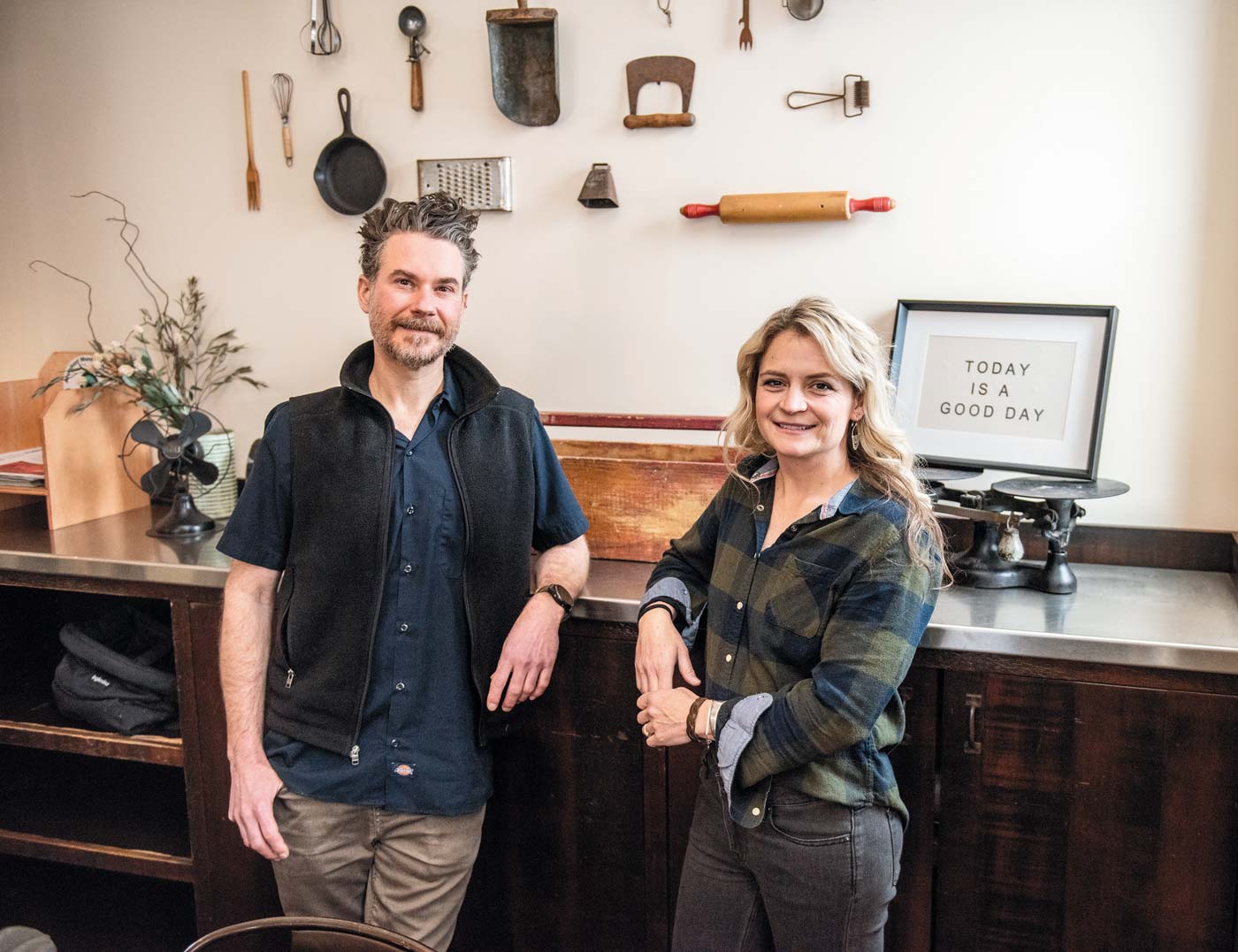Nate Powell-Palm, owner of Cold Springs Organics, and Tanner Houselog, the operation’s director of marketing, pause during harvest. Cold Springs produces seven crops on rotation from leased fields near Belgrade.
Developing a Local Flour Mill
It is an early fall morning as I drive around Belgrade with Nate Powell-Palm, watching the sun rise over fields of swollen, organic grain heads. We make our way through the patchwork of fields that Powell-Palm leases to grow durum wheat, hard red spring wheat, yellow peas, alfalfa, flax, lentils, and spelt on a seven year rotation. He sells his harvest through his business, Cold Springs Organics. At 32 years old, Powell-Palm has already achieved many things: becoming a first-generation producer, the youngest certified-organic farmer in the country, an involved and informed community member, and a creative, forward-thinking entrepreneur.
When Powell-Palm was 9, he began to explore the world of agriculture through his participation in 4-H showing a steer at the Gallatin County Fair. As a kid, he says, it was exciting to think that “there’s this world out there where your job can be spending your days outside, raising livestock and stewarding land.”
A few years later, he took out a Junior Agriculture Loan from the Montana Department of Agriculture (a program that is still available today). He used that funding to purchase three bred cows, hay, fencing panels, and a stock trailer that he still has to this day. Even as a teenager, Powell-Palm recognized the reality that many young and first-generation farmers struggle with: Without land or a farm business to inherit, he would have to be strategic to make his business profitable.
With the help of mentors, Powell-Palm transitioned his operation to certified organic in 2009, at the age of 17, having recognized the added value this certification would bring to his products. Soon after, he became more involved with the organic community, joining the Montana Organic Producer Co-op and the Montana Organic Association.
By 2012, Powell-Palm was successfully raising and selling finished organic cattle. As he looked through his expenses, he realized he could increase his profits by producing his own primary input: hay to feed his cattle. He reached out to landowners in the Gallatin Valley asking if he could lease their land.
“In 2012, I sent about 90 letters in one summer and got about a dozen responses,” he says. “The positive responses said, ‘Sure thing. We’ll lease to you on very favorable terms.’” As the grain business grew, he was able not only to feed his own livestock, but also to sell his hay to other organic growers in the region.
One challenge Powell-Palm faced as he transitioned leased parcels to certified organic was weed suppression. In an attempt to address this problem and introduce rotational crops into his operation, Powell-Palm began growing wheat. That year, he was amazed: “I made more money off of that first crop of soft white spring wheat than I ever would have off of hay.”
After that, Powell-Palm decided to try his hand at growing a variety of crops such as oats, emmer, and yellow peas. He was able to establish markets with major companies such as Annie’s, all the while embracing rotational crops that benefitted the soil’s health. This initial crop diversification was another step along Powell-Palm’s journey of adapting the business to meet the needs of local and regional markets.
In 2020, when COVID began to affect national supply chains, Powell-Palm received calls from grocery stores asking to purchase value-added goods, such as milled flour and totes of clean grain and yellow peas. Up to that point, Powell-Palm had sold his grain and pulse crops to grain elevators, as most producers do, in their raw, unprocessed form. These elevators would eventually sell the crops to milling facilities, where they were processed into a usable end product such as flour. Oftentimes, this supply chain moves grain in and out of several states before it is sold to food companies and grocery stores.
“Right now, we actually don’t have an elevator in the Gallatin Valley,” Powell-Palm says. “Grain will go maybe 30 to 100 miles away to get dropped off, and then much of it will go to the big milling areas like northern or central Montana or the Great Falls area, but a lot of it will go out of state. It will get shipped out to Chicago or Denver, and then a ton of it goes as export.”
While common practice today, this supply chain is relatively new. Prior to the establishment of a robust rail system in the United States, the lack of transit required most towns to grow and process their own grains locally. The history of flour milling in Gallatin Valley followed alongside this national trend. In the fall of 1864, Gallatin County’s first flour mill was built by Thomas Cover and the McAdow brothers. In 1883, the first railroad came to the Gallatin Valley allowing for the transportation of agricultural goods from Oregon to Wisconsin. That same year Cover and McAdows’ mill closed.
Today, according to the global analytics firm IBIS World, there are approximately 645 flour milling businesses in the U.S. with the top four flour milling companies generating 32 percent of market revenue. This type of consolidation is common across the agriculture industry more broadly. The descendants of the Bon-Ton Flour Mill, which was located at the corner of North Wallace Avenue and East Peach Street, closed in the 1970s, likely due to the inability to compete with large national flour companies. However, over the last 20 years we have seen a resurgence of small mills as consumers become more interested in product traceability. Oftentimes, small mills are in a position to pay growers in their region more per bushel than large grain processors.
With an eye on national markets, Powell-Palm began to ask himself: “Do we want to ship grain away and then buy it back with the value being added elsewhere?” This line of questioning led him to apply and receive funding through the Montana Department of Agriculture’s Growth Through Agriculture Program in 2022 and 2023 for grain processing infrastructure. Powell- Palm is using these grant funds to purchase equipment that will allow him to clean, mill, and bag his own wheat and allow him to offer custom processing for other growers. This facility will operate under the name Bozeman Flour, and Powell-Palm expects to have products ready for market by May 2024.
Instead of disposing of the main byproduct from the seed cleaning plant, Powell-Palm will use the grain screenings from the cleaning operation to create pelletized animal feed. This will solve yet another issue farmers in our area face: access to affordable, organic feed for their livestock. All these varied business endeavors are Powell-Palm’s effort to establish market outlets for agricultural products that improve soil health while also creating greater value for farmers in our community.
Powell-Palm truly feels there is power in the ability to “identify those foods that our community needs and take care of them locally. … I imagine thriving food economies popping up in every community. When you roll into town in Bozeman, you know that you’re going to be able to go to a brewery and grab a worldclass beer that can be made with locally malted barley. Then you can roll on over to buy some great fresh bread made with locally milled flour.”
Most of us have fond memories of splitting a Fink’s sandwich with a friend, having important conversations between bites of a Wild Crumb pastry, or showing up to work hungry only to find a box of Granny’s Donuts in the break room. Keeping money in our local economy is yet another way to make sure we are supporting our neighbors, and as Powell-Palm likes to say: “Carbs make community.”
Many farmers throughout Montana are having impactful conversations about building our food systems in community with each other. “It’s going to take all of us,” Powell-Palm says. “It’s a lot of work, but it’s really exciting work that I think we could all derive a lot of joy from.”




